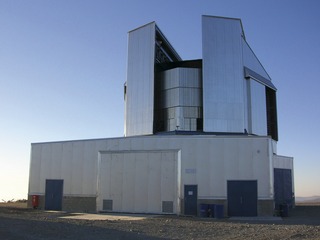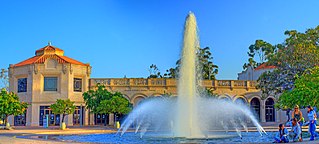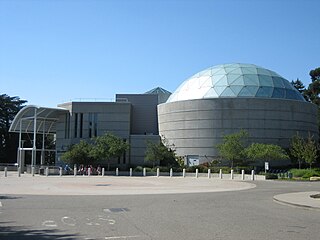
A planetarium is a theatre built primarily for presenting educational and entertaining shows about astronomy and the night sky, or for training in celestial navigation.

IMAX is a proprietary system of high-resolution cameras, film formats, film projectors, and theaters known for having very large screens with a tall aspect ratio and steep stadium seating, with the 1.43:1 ratio format being available only in few selected locations.

The VISTA is a wide-field reflecting telescope with a 4.1 metre mirror, located at the Paranal Observatory in Chile. It is operated by the European Southern Observatory and started science operations in December 2009. VISTA was conceived and developed by a consortium of universities in the United Kingdom led by Queen Mary University of London and became an in-kind contribution to ESO as part of the UK's accession agreement, with the subscription paid by the UK Science and Technology Facilities Council (STFC).

The Anglo-Australian Telescope (AAT) is a 3.9-metre equatorially mounted telescope operated by the Australian Astronomical Observatory and situated at the Siding Spring Observatory, Australia, at an altitude of a little over 1,100 m. In 2009, the telescope was ranked as having the fifth-highest-impact of the world's optical telescopes. In 2001–2003, it was considered the most scientifically productive 4-metre-class optical telescope in the world based on scientific publications using data from the telescope.

Siding Spring Observatory near Coonabarabran, New South Wales, Australia, part of the Research School of Astronomy & Astrophysics (RSAA) at the Australian National University (ANU), incorporates the Anglo-Australian Telescope along with a collection of other telescopes owned by the Australian National University, the University of New South Wales, and other institutions. The observatory is situated 1,165 metres (3,822 ft) above sea level in the Warrumbungle National Park on Mount Woorat, also known as Siding Spring Mountain. Siding Spring Observatory is owned by the Australian National University (ANU) and is part of the Mount Stromlo and Siding Spring Observatories research school.
The UK Schmidt Telescope (UKST) is a 1.24 metre Schmidt telescope operated by the Australian Astronomical Observatory ; it is located adjacent to the 3.9 metre Anglo-Australian Telescope at Siding Spring Observatory, Australia. It is very similar to the Samuel Oschin telescope in California. The telescope can detect objects down to magnitude 21 after an hour of exposure on photographic plates.

The Science Centre Singapore, previously known as Singapore Science Centre is a scientific institution in Jurong East, Singapore, specialising in the promotion of scientific and technological education for the general public. It houses over 850 exhibits over eight exhibition galleries and receives over a million visitors every year. In 2003, it celebrated its silver jubilee.

The Fleet Science Center is a science museum and planetarium in Balboa Park, located in San Diego, California. It is at the east end of the El Prado Drive walkway, next to the Bea Evenson Fountain and plaza in central Balboa Park.

Telus World of Science Edmonton (TWOSE) is a broad-based science centre in Edmonton, Alberta, Canada, operated by the (non-profit) Edmonton Space & Science Foundation. The centre is located on the southwest corner of Coronation Park in the neighborhood of Woodcroft. The science centre houses 144,430 sq. ft. of public space and is the largest science centre in Western Canada. It is currently a member of both the Association of Science-Technology Centers (ASTC) and the Canadian Association of Science Centres (CASC).

The Astronomical Observatory of Modra, also known as Modra Observatory or the Astronomical and Geophysical observatory in Modra, is an astronomical observatory located in Modra, Slovakia. It is owned and operated by the Comenius University in Bratislava. The scientific research at the observatory is led by the Department of Astronomy, Physics of the Earth and Meteorology, Faculty of Mathematics, Physics and Informatics.

The Royal Observatory, Edinburgh (ROE) is an astronomical institution located on Blackford Hill in Edinburgh. The site is owned by the Science and Technology Facilities Council (STFC). The ROE comprises the UK Astronomy Technology Centre (UK ATC) of STFC, the Institute for Astronomy of the School of Physics and Astronomy of the University of Edinburgh, and the ROE Visitor Centre.

A solar telescope is a special purpose telescope used to observe the Sun. Solar telescopes usually detect light with wavelengths in, or not far outside, the visible spectrum. Obsolete names for Sun telescopes include heliograph and photoheliograph.

Chabot Space and Science Center, located in Oakland, California, is a center for learning in Earth and space science, which features interactive exhibits, planetariums, a large screen theater, hands-on activities, and three powerful telescopes.

The Sir Thomas Brisbane Planetarium is located on the grounds of the Brisbane Botanic Gardens in the suburb of Mount Coot-tha, Brisbane, Queensland, Australia. The Planetarium was officially opened on 24 May 1978.
Fulldome refers to immersive dome-based video display environments. The dome, horizontal or tilted, is filled with real-time (interactive) or pre-rendered (linear) computer animations, live capture images, or composited environments.

Bosscha Observatory is the oldest modern observatory in Indonesia, and one of the oldest in Asia. The observatory is located in Lembang, West Bandung Regency, West Java, approximately 15 kilometers (9.3 mi) north of Bandung. It is situated on a hilly six hectares of land and is 1,310 m (4,300 ft) above mean sea level plateau. The IAU observatory code for Bosscha is 299.

Urania Sternwarte is a public observatory in the Lindenhof quarter of Zürich, Switzerland. Its name Urania refers to the muse of astronomy in Greek mythology.

National Astronomical Research Institute of Thailand or NARIT is a research institute under the Ministry of Higher Education, Science, Research and Innovation. NARIT is headquartered in Chiang Mai, Thailand. The main missions of the institute are to carry out, support, and promote the development of astronomy and astrophysics in Thailand through research, public outreach, and educational activities.

The Ankara University Observatory (AUG), is a ground-based astronomical observatory operated by the Astronomy and Space Sciences Department at Ankara University's Faculty of Science. Established in 1959 by Dutch astronomer Egbert Adriaan Kreiken in Ahlatlıbel, Ankara. Currently, it consists of nine optical telescopes and a radio telescope, which is currently taken out of service. Old instruments are displayed in a museum at the observatory.

The Istanbul University Observatory is a ground-based astronomical observatory operated by the Astronomy and Space Sciences Department at Istanbul University's Faculty of Science. Established in 1936, it is situated next to the historic Beyazıt Tower within the main campus of the university at Beyazıt Square in Fatih district of Istanbul, Turkey.




















